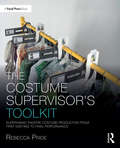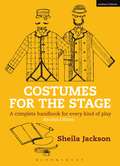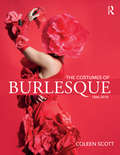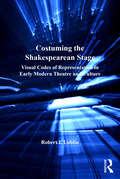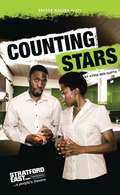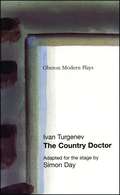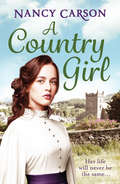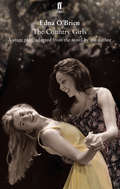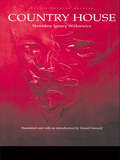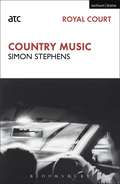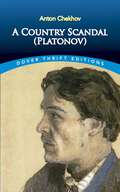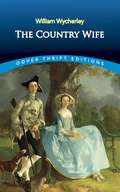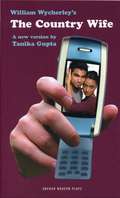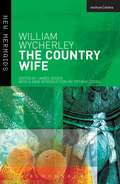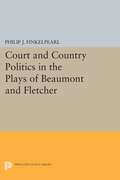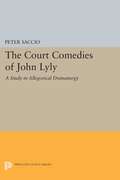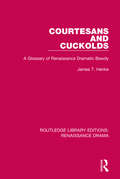- Table View
- List View
The Costume Supervisor’s Toolkit: Supervising Theatre Costume Production from First Meeting to Final Performance (The Focal Press Toolkit Series)
by Rebecca PrideThe Costume Supervisor’s Toolkit explores the responsibilities of a Costume Supervisor within a theatrical, opera or dance production company. Rebecca Pride provides an insight into all manner of processes, beginning with a definition of the role, and offers explanations of the timeline from the first design meetings, leading all the way up to managing fittings and final rehearsals. This how-to guide outlines best working practices, including building a team and creating a Costume Bible, whilst also providing helpful resources such as sizing guides, a list of useful addresses, and case studies from renowned theatrical organizations.
Costumes for the Stage: A complete handbook for every kind of play (Backstage)
by Sheila JacksonFor anyone producing costumes on a small budget, whether for schools, colleges or amateur, semi-professional or professional groups, this basic introduction offers practical advice for every kind of play, together with drawings, diagrams and patterns from which to work. It includes sections onm Greek plays, medieval miracles and mysteries, Shakespeare, 17th-century, 18th-century, Victorian and Edwardian costume. each section covers the details of men's and women's clothes and accessories, as well as methods for adapting and simplifying the style of the period.
Costumes for the Stage: A complete handbook for every kind of play (Backstage)
by Sheila JacksonFor anyone producing costumes on a small budget, whether for schools, colleges or amateur, semi-professional or professional groups, this basic introduction offers practical advice for every kind of play, together with drawings, diagrams and patterns from which to work. It includes sections onm Greek plays, medieval miracles and mysteries, Shakespeare, 17th-century, 18th-century, Victorian and Edwardian costume. each section covers the details of men's and women's clothes and accessories, as well as methods for adapting and simplifying the style of the period.
The Costumes of Burlesque: 1866-2018
by Coleen ScottThe Costumes of Burlesque: 1866-2018 is the first volume to inclusively document burlesque costume from its birth in the 1860’s through the global burlesque movement in 2018. This lushly illustrated book presents the history and development of this American art form by documenting the origins, influencers, and genuine articles that created its aesthetic. Showcases of legendary performers, including Lydia Thompson, Gypsy Rose Lee, Sally Rand, Bettie Page, Kitten Natividad, and Dita Von Teese, demonstrate costume styles through the years. This guide gives readers a clear view of how burlesque costume looked and why. It teaches collectors, burlesque performers, and fans alike to recognize vintage pieces for what they are and to design their own costumes with inspiration from the originals. By including detailed costume documentation, over 400 images, and interviews with prominent costume designers such as Catherine D’Lish and Garo Sparo, The Costumes of Burlesque brings 150 years of burlesque costume history to life.
The Costumes of Burlesque: 1866-2018
by Coleen ScottThe Costumes of Burlesque: 1866-2018 is the first volume to inclusively document burlesque costume from its birth in the 1860’s through the global burlesque movement in 2018. This lushly illustrated book presents the history and development of this American art form by documenting the origins, influencers, and genuine articles that created its aesthetic. Showcases of legendary performers, including Lydia Thompson, Gypsy Rose Lee, Sally Rand, Bettie Page, Kitten Natividad, and Dita Von Teese, demonstrate costume styles through the years. This guide gives readers a clear view of how burlesque costume looked and why. It teaches collectors, burlesque performers, and fans alike to recognize vintage pieces for what they are and to design their own costumes with inspiration from the originals. By including detailed costume documentation, over 400 images, and interviews with prominent costume designers such as Catherine D’Lish and Garo Sparo, The Costumes of Burlesque brings 150 years of burlesque costume history to life.
Costuming the Shakespearean Stage: Visual Codes of Representation in Early Modern Theatre and Culture
by Robert I. LublinAlthough scholars have long considered the material conditions surrounding the production of early modern drama, until now, no book-length examination has sought to explain what was worn on the period's stages and, more importantly, how articles of apparel were understood when seen by contemporary audiences. Robert Lublin's new study considers royal proclamations, religious writings, paintings, woodcuts, plays, historical accounts, sermons, and legal documents to investigate what Shakespearean actors actually wore in production and what cultural information those costumes conveyed. Four of the chapters of Costuming the Shakespearean Stage address 'categories of seeing': visually based semiotic systems according to which costumes constructed and conveyed information on the early modern stage. The four categories include gender, social station, nationality, and religion. The fifth chapter examines one play, Thomas Middleton's A Game at Chess, to show how costumes signified across the categories of seeing to establish a play's distinctive semiotics and visual aesthetic.
Costuming the Shakespearean Stage: Visual Codes of Representation in Early Modern Theatre and Culture
by Robert I. LublinAlthough scholars have long considered the material conditions surrounding the production of early modern drama, until now, no book-length examination has sought to explain what was worn on the period's stages and, more importantly, how articles of apparel were understood when seen by contemporary audiences. Robert Lublin's new study considers royal proclamations, religious writings, paintings, woodcuts, plays, historical accounts, sermons, and legal documents to investigate what Shakespearean actors actually wore in production and what cultural information those costumes conveyed. Four of the chapters of Costuming the Shakespearean Stage address 'categories of seeing': visually based semiotic systems according to which costumes constructed and conveyed information on the early modern stage. The four categories include gender, social station, nationality, and religion. The fifth chapter examines one play, Thomas Middleton's A Game at Chess, to show how costumes signified across the categories of seeing to establish a play's distinctive semiotics and visual aesthetic.
Counting Stars (Oberon Modern Plays)
by Atiha Sen GuptaWoolwich. Club Paradise. Valentine’s Night. Nigerian nightclub toilet attendants Abiodun and Sophie brace themselves for the busiest night of the year: loved up couples; rowdy singletons; and everything in between. The clubbers aren’t the only ones celebrating though. Tonight Abiodun and Sophie are marking their one year anniversary together having met in Paradise: united in love, divided by a toilet wall. But as the countdown to midnight and the end of their shift begins, bosses, exes and clubbers threaten to stall the anniversary plans of the young lovers. Will Abiodun and Sophie be forever destined to facilitate the love lives of others or will they insist on making it back in time for their very own Valentine’s celebration?
The Country Doctor (Oberon Modern Plays Ser.)
by Ivan Turgenev Simon Paisley Day'I've come across some stories in my time. The things people tell you when they think they're on the brink...' A country doctor recounts a story to an aspiring Russian novelist. The tale is unexpected, short and bittersweet, rather like its subject: a love affair between the doctor and his dying patient, the beautiful and cultured Alexandra Andreyevna. Thrown together by her condition, they find a love imbued with an honesty and an urgency that most would find unbearable. But this young woman's life is particularly fragile and in his desperate bid to cure her the doctor unwittingly prescribes the most dangerous drug of all. The Country Doctor was first published in the Russian literary magazine The Contemporary in the late 1840s. It was one of many tales which would later comprise The Sportsman's Notebook. Simon Day dramatises this enchanting story of frustrated love, bringing the elegance of Turgenev's prose to life in a new way.
A Country Girl
by Nancy CarsonA must-read sweeping saga, full of intrigue, romance and page-turning drama . . .
Country Girls (The\country Girls Trilogy Ser. #1)
by Edna O'BrienEdna O'Brien's wonderful, wild and moving novel shocked the nation on its publication in 1960. Adapted for the stage by the author, The Country Girls, the play, is a highly theatrical and free-flowing telling of this classic coming of age story.
Country House: Polish Theatre Archive
by Stanislav I. Witkiewicz D. GerouldCountry House, a ''comedy with corpses,'' is a wicked subversion of all those realistic psychological dramas of jealousy, adultery, murder and suicide that ask to be taken seriously. Witkacy's send-up assumes the form of a ghost story full of surprises, in the course of which an entire family of four is gleefully dispatched to the other world. When it was first performed in 1923 in Torun, Country House was judged unsuitable for the general public because it derided moral, social and dramatic convention. Three years later, as directed by the playwright himself in Lwów, the drama proved an unexpected success with audiences (although it only ran for four nights) and ever since has been among Witkacy's most frequently performed works. Today we can appreciate Country House not only as a systematic demolition of stage realism, but also as an anxious probing of the elusive boundaries between life and death, exposing the ''dark places'' of the human psyche that make us laugh nervously.
Country House: Polish Theatre Archive
by Stanislav I. Witkiewicz D. GerouldCountry House, a ''comedy with corpses,'' is a wicked subversion of all those realistic psychological dramas of jealousy, adultery, murder and suicide that ask to be taken seriously. Witkacy's send-up assumes the form of a ghost story full of surprises, in the course of which an entire family of four is gleefully dispatched to the other world. When it was first performed in 1923 in Torun, Country House was judged unsuitable for the general public because it derided moral, social and dramatic convention. Three years later, as directed by the playwright himself in Lwów, the drama proved an unexpected success with audiences (although it only ran for four nights) and ever since has been among Witkacy's most frequently performed works. Today we can appreciate Country House not only as a systematic demolition of stage realism, but also as an anxious probing of the elusive boundaries between life and death, exposing the ''dark places'' of the human psyche that make us laugh nervously.
Country Music (Modern Plays)
by Simon StephensDramatic new play of crime and redemption by winner of Pearson Most Promising New Playwright Award, 2001A story of crime and redemption, starting at the mouth of the River Thames and moving across England over twenty years. It begins with a life choice for Jamie Carris and ends with a re-union with his young daughter. It is also a story about a killer.
Country Music: One Minute - Country Music - Motortown - Pornography - Sea Wall (Modern Plays)
by Simon StephensDramatic new play of crime and redemption by winner of Pearson Most Promising New Playwright Award, 2001A story of crime and redemption, starting at the mouth of the River Thames and moving across England over twenty years. It begins with a life choice for Jamie Carris and ends with a re-union with his young daughter. It is also a story about a killer.
A Country Scandal (Dover Thrift Editions)
by Anton Chekhov Alex SzogyiA Russian version of Don Juan is the focus of Chekhov's first play, a farce in which a newly arrived schoolmaster proves irresistible to the bored women of a provincial community. Platonov's charm lies in his novelty, and his seductions are strictly passive as a libidinous widow, her idealistic stepdaughter, and an earnest student vie for his romantic attentions. Discovered in 1923, two decades after Chekhov's death, this play was written while the author was still a medical student. Adapted and translated by Alex Szogyi, it offers the trenchant wit and rich characterizations typical of the dramatist's later works. Woven amid the love affairs, suicide attempts, parties, and shootings are the customary themes of Chekhovian theater: the passions and frailties of human nature, the futility of the search for happiness, and the alternating episodes of comedy and tragedy that shape every life.
The Country Wife: A Comedy, As It Is Acted At The Theatre-royal. Written By Mr. Wycherley
by William WycherleyOriginally performed and published in 1675, this five-act play parodies the vices and hypocrisies of Restoration London. The plot centers on the eponymous country wife, Margery, whose suspicious husband, Mr. Pinchwife, keeps her isolated. On a rare outing to the theater, Margery encounters the aptly named Mr. Horner. A notorious rake who feigns impotence to trick his way into the intimate company of married ladies, Horner soon schools Margery in the art of deception and realizes Pinchwife's worst fears. Bursting with racy dialog and bawdy humor, this comic masterpiece offers an enduring blend of cynicism, satire, and farce. The elegance of the play's construction and the glamour of its setting provide a piquant contrast to its earthy celebration of lust and human folly. The Country Wife has been periodically vilified for its immorality but remains ever popular for its lively characters, witty double entendres, and sophisticated drama.
The Country Wife (Oberon Modern Plays)
by William Wycherley Tanika GuptaThis new version of William Wycherley 's most famous classic, The Country Wife has been adapted by Tanika Gupta, one of the country 's leading playwrights. This contemporary farce tells the story of twenty-something friends and rivals on their journey through love and liberation.Following Hardeep 's return to London he begins broadcasting his newly invented celibate state in a bid to attract women keen to reignite his passion for them. With this deception more than successful his endeavours turn to the naive country wife, Preethi, Alok's virgin bride to settle unfinished business between old friends. A fast paced comedy laced with deception, disguise and lustful behaviour brought about by double standards, adultery and promiscuous living.Country Wife was performed at the Watford Palace theatre in October 2004
The Country Wife (New Mermaids)
by William Wycherley Tiffany Stern James Ogden'He's a fool that marries, but he's a greater fool that does not marry a fool.'This bawdy, hilarious, subversive and wickedly satirical drama pokes fun at the humourless, the jealous, and the adulterous alike. It features a country wife, Margery, whose husband believes she is too naïve to cuckold him; and an anti-hero, Horner, who pretends to be impotent in order to have unrestrained access to the women keen on 'the sport'. A number of licentious and hypocritical women request Horner's services – the country wife among them. The Country Wife has provoked powerfully mixed reactions over the years. The seventeenth century libertine king Charles II saw it twice, and is said to have joined the 'dance of the cuckolds' at the end of one performance; the eighteenth century actor-playwright David Garrick declared it 'the most licentious play in the English language'; the Victorian Macaulay compared it to a skunk, because it was 'too filthy to handle and too noisome even to approach'. Twentieth century productions heralded it a Restoration masterpiece. Sexually frank, and as ready to criticise marriage as infidelity, the virtuosity, linguistic energy, brilliant wit, naughtiness and complexity of this ribald play have made it a staple of the modern stage. This student edition contains a lengthy, entirely new introduction, by leading scholar, Tiffany Stern, with a background on the author, structure, characters, genre, themes, original staging and performance history, as well as an updated bibliography and a fully annotated version of the playtext.
The Country Wife: A Comedy, As It Is Acted At The Theatre-royal. Written By Mr. Wycherley (New Mermaids)
by William Wycherley Tiffany Stern James Ogden'He's a fool that marries, but he's a greater fool that does not marry a fool.'This bawdy, hilarious, subversive and wickedly satirical drama pokes fun at the humourless, the jealous, and the adulterous alike. It features a country wife, Margery, whose husband believes she is too naïve to cuckold him; and an anti-hero, Horner, who pretends to be impotent in order to have unrestrained access to the women keen on 'the sport'. A number of licentious and hypocritical women request Horner's services – the country wife among them. The Country Wife has provoked powerfully mixed reactions over the years. The seventeenth century libertine king Charles II saw it twice, and is said to have joined the 'dance of the cuckolds' at the end of one performance; the eighteenth century actor-playwright David Garrick declared it 'the most licentious play in the English language'; the Victorian Macaulay compared it to a skunk, because it was 'too filthy to handle and too noisome even to approach'. Twentieth century productions heralded it a Restoration masterpiece. Sexually frank, and as ready to criticise marriage as infidelity, the virtuosity, linguistic energy, brilliant wit, naughtiness and complexity of this ribald play have made it a staple of the modern stage. This student edition contains a lengthy, entirely new introduction, by leading scholar, Tiffany Stern, with a background on the author, structure, characters, genre, themes, original staging and performance history, as well as an updated bibliography and a fully annotated version of the playtext.
Court and Country Politics in the Plays of Beaumont and Fletcher (PDF)
by Philip J. FinkelpearlThe seventeenth-century English collaborative authors Francis Beaumont and John Fletcher were not only the most popular playwrights of their day but also literary figures highly esteemed by the great critics of the age, Jonson and Dryden. Concentrating on the passions of the royalty and high nobility in a courtly atmosphere, their dramas are now usually seen as epitomizing a decadent turn in theater at the end of the Jacobean period. Philip Finkelpearl sets out to change this view by revealing the subtle political challenges contained in the plays and by showing that they criticize rather than exemplify false values. The result is a wholly new conception of this pair of dramatists and of the entire question of the relationship between the Crown and the theater in their time. Finkelpearl presents new biographical material revealing that Beaumont and Fletcher had good and sufficient reasons to be critical of the court and the king, and he shows that their most important works--especially The Knight of the Burning Pestle, Philaster, A King and No King, and The Maid's Tragedy have such criticism as a central concern. Court and Country Politics in the Plays of Beaumont and Fletcher offers much information on the nature of the "public" and "private" theaters at which these plays were presented and on Jacobean censorship. The book is an impressive explanation of why Beaumont and Fletcher were a central force in the Age of Shakespeare.Originally published in 1990.The Princeton Legacy Library uses the latest print-on-demand technology to again make available previously out-of-print books from the distinguished backlist of Princeton University Press. These editions preserve the original texts of these important books while presenting them in durable paperback and hardcover editions. The goal of the Princeton Legacy Library is to vastly increase access to the rich scholarly heritage found in the thousands of books published by Princeton University Press since its founding in 1905.
The Court Comedies of John Lyly: A Study in Allegorical Dramaturgy
by Peter SaccioThe nature of Renaissance allegory has been the subject of much investigation, notably by Spenserian scholars. The subject is now enlarged through a study of the plays of the Elizabethan Court dramatists of the 1580's and early 1590’s, particularly the comedies of John Lyly. Mr. Saccio rejects the older "topical readings" of Lyly; by extensive interpretation of particular plays he describes three distinct kinds of allegorical operation apparent in successive phases of Lyly’s career and suggests that they form an important paradigm of the development of English drama itself.Originally published in 1969.The Princeton Legacy Library uses the latest print-on-demand technology to again make available previously out-of-print books from the distinguished backlist of Princeton University Press. These editions preserve the original texts of these important books while presenting them in durable paperback and hardcover editions. The goal of the Princeton Legacy Library is to vastly increase access to the rich scholarly heritage found in the thousands of books published by Princeton University Press since its founding in 1905.
Courtesans and Cuckolds: A Glossary of Renaissance Dramatic Bawdy (Routledge Library Editions: Renaissance Drama)
by James T. HenkeThis title, first published in 1979, is a glossary of the bawdy vocabulary that was used in Renaissance Drama. One of the primary functions of this gloss of literary bawdy is to interpret imaginative uses of the language rather than simply record the generally accepted uses and meanings, with its principal task to make the dialogue of the plays more intelligible to the reader. With examples of bawdy language used in the works of Shakespeare, Ben Jonson and John Webster amongst many others, this title will be of great interest to students of literature and performance studies.
Courtesans and Cuckolds: A Glossary of Renaissance Dramatic Bawdy (Routledge Library Editions: Renaissance Drama)
by James T. HenkeThis title, first published in 1979, is a glossary of the bawdy vocabulary that was used in Renaissance Drama. One of the primary functions of this gloss of literary bawdy is to interpret imaginative uses of the language rather than simply record the generally accepted uses and meanings, with its principal task to make the dialogue of the plays more intelligible to the reader. With examples of bawdy language used in the works of Shakespeare, Ben Jonson and John Webster amongst many others, this title will be of great interest to students of literature and performance studies.
